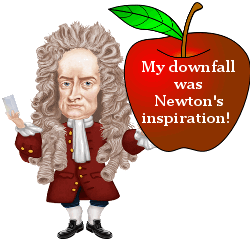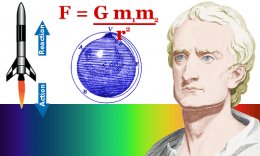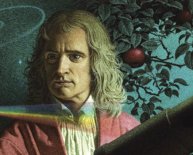
Major achievements of Galileo Galilei
 Reading the works of these great scientists, Newton grew more ambitious about making discoveries himself. While still working part-time as a servant, he wrote a note to himself. In it he posed questions which had not yet been answered by science. These included questions about gravity, the nature of light, the nature of color and vision, and atoms.
Reading the works of these great scientists, Newton grew more ambitious about making discoveries himself. While still working part-time as a servant, he wrote a note to himself. In it he posed questions which had not yet been answered by science. These included questions about gravity, the nature of light, the nature of color and vision, and atoms.
After three years at Cambridge he won a four-year scholarship, allowing him to devote his time fully to academic studies.
A Mind on Fire
In 1665, at the age of 22, a year after beginning his four-year scholarship, he made his first major discovery: this was in mathematics, where he discovered the generalized binomial theorem. In 1665 he was also awarded his B.A. degree.
By now Newton’s mind was ablaze with new ideas. He began making significant progress in three distinct fields – fields in which he would make some of his most profound discoveries:
- calculus, the mathematics of change, which is vital to our understanding of the world around us
- gravity
- optics and the behavior of light
He did much of his work on these topics back home at Woolsthorpe-by-Colsterworth after the Great Plague forced his college in Cambridge to close.
Fellow and Lucasian Professor of Mathematics
At the age of 24, in 1667, he returned to Cambridge, where events moved quickly.
First he was elected as a fellow of Trinity College.
 A year later, in 1668, he was awarded an M.A. degree.
A year later, in 1668, he was awarded an M.A. degree.
A year after that, the Lucasian Professor of Mathematics at Trinity College, Isaac Barrow, resigned and Newton was appointed as his replacement; he was just 26 years old. Barrow, who had recommended that Newton should succeed him, said of Newton’s skills in mathematics:
“Mr Newton, a fellow of our College, and very young, being but the second year master of arts; but of an extraordinary genius and proficiency.”
Isaac Barrow
Mathematician
Achievements in Brief
Isaac Newton, who was largely self-taught in mathematics and physics:
- generalized the binomial theorem
- showed that sunlight is made up of all of the colors of the rainbow. He used one glass prism to split a beam of sunlight into its separate colors, then another prism to recombine the rainbow colors to make a beam of white light again.
- built the world’s first working reflecting telescope.
- discovered/invented calculus, the mathematics of change, without which we could not understand the behavior of objects as tiny as electrons or as large as galaxies.
- wrote the Principia, one of the most important scientific books ever written; in it he used mathematics to explain gravity and motion. (Principia is pronounced with a hard c.)
- discovered the law of universal gravitation, proving that the force holding the moon in orbit around the earth is the same force that causes an apple to fall from a tree.
- formulated his three laws of motion – Newton’s Laws – which lie at the heart of the science of movement.
- showed that Kepler’s laws of planetary motion are special cases of Newton’s universal gravitation.
- proved that all objects moving through space under the influence of gravity must follow a path shaped in the form of one of the conic sections, such as a circle, an ellipse, or a parabola, hence explaining the paths all planets and comets follow.
- showed that the tides are caused by gravitational interactions between the earth, the moon and the sun.
- predicted, correctly, that the earth is not perfectly spherical but is squashed into an oblate spheroid, larger around the equator than around the poles.
- Used mathematics to model the movement of fluids – from which the concept of a Newtonian fluid comes.
- devised Newton’s Method for finding the roots of mathematical functions.
A cylinder of air reaching to the top of the atmosphere is of equal weight with a cylinder of water about 33 feet high.
 Isaac Newton
Isaac Newton
Some Details about Newton’s Greatest Discoveries
Newton revealed his laws of motion and gravitation in his book the Principia. Just as few people at first could understand Albert Einstein’s general theory of relativity, few people understood the Principia when it was published. When Newton walked past them one day, one student remarked to another:
“There goes a man who has written a book that neither he nor anybody else understands.”
Newton’s ideas were spread by the small number of people who understood the Principia, and who were able to convey its message in more accessible ways: people including Leonard Euler, Joseph Louis Lagrange, Pierre Simon de Laplace, Willem Jacob ‘s Gravesande, William Whiston, Voltaire, John Theophilus Desaguliers, and David Gregory.
Calculus
Newton was the first person to fully develop calculus. Calculus is the mathematics of change. Modern physics and physical chemistry would be impossible without it. Other academic disciplines such as biology and economics also rely heavily on calculus for analysis.
In his development of calculus Newton was influenced by Pierre de Fermat, who had shown specific examples in which calculus-like methods could be used. Newton was able to build on Fermat’s work and generalize calculus. Newton wrote that he had been guided by:
“Monsieur Fermat’s method of drawing tangents.”
Isaac Newton
Mathematician and Physicist
From Newton’s fertile mind came the ideas that we now call differential calculus, integral calculus and differential equations.
Soon after Newton generalized calculus, Gottfried Leibniz achieved the same result. Today, most mathematicians give equal credit to Newton and Leibniz for calculus’s discovery.
Universal Gravitation and the Apple
Newton’s famous apple, which he saw falling from a tree in the garden of his family home in Woolsthorpe-by-Colsterworth, is not a myth.
He told people that seeing the apple’s fall made him wonder why it fell in a straight line towards the center of our planet rather than moving upwards or sideways.
















